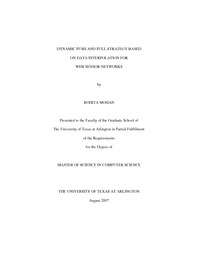| dc.contributor.author | Mohan, Rohita | en_US |
| dc.date.accessioned | 2007-09-17T17:07:34Z | |
| dc.date.available | 2007-09-17T17:07:34Z | |
| dc.date.issued | 2007-09-17T17:07:34Z | |
| dc.date.submitted | August 2007 | en_US |
| dc.identifier.other | DISS-1828 | en_US |
| dc.identifier.uri | http://hdl.handle.net/10106/616 | |
| dc.description.abstract | Sensor Web, a new trend has been developed recently to effectively network large scale deployed heterogeneous sensors with Internet to make sensor data discoverable, accessible and controllable via World Wide Web. Since sensor nodes are highly resource constrained, continuous back hauling of a large amount of data is not feasible. In this paper, we propose a dynamic push/pull service architecture where sensory quality is dynamically monitored and controlled. The architecture is implemented in a web proxy residing at the gateway of the network. As data is being pushed continuously from the network for effective sketching of the sensing field, interpolation techniques are employed to further render the details. Due to varying user requirements and dynamics of the sensing field, pushed data only may lead to low quality of the interpolated data. In this case, the system will dynamically pull data from the sensing field based on the requirements of the interpolation algorithms for desired confidence. Also, continuous demands of data pulling will eventually be converted to pushing services in order to reduce system overhead. The overall result is an architecture where push and pull services are dynamically monitored in order to reduce the overall system energy while satisfying user's demand for sensory data quality.
Simulation of a web proxy has been conducted to continuously regulate the push and pull rates of temperature data based on Spatial Point to Point Interpolation algorithm, which has been proved appropriate for GIS applications. From our simulation results, the optimal degree of push and pull rates is determined to maintain high quality of sensor data delivered to the users while reducing overall system energy but it can also be seen that with an increase in the accuracy of the interpolated data, there is a tradeoff in the energy consumption level of sensor nodes. | en_US |
| dc.description.sponsorship | Liu, Yonghe | en_US |
| dc.language.iso | EN | en_US |
| dc.publisher | Computer Science & Engineering | en_US |
| dc.title | Dynamic Push And Pull Strategy Based On Data Interpolation For Web Sensor Networks | en_US |
| dc.type | M.S. | en_US |
| dc.contributor.committeeChair | Liu, Yonghe | en_US |
| dc.degree.department | Computer Science & Engineering | en_US |
| dc.degree.discipline | Computer Science & Engineering | en_US |
| dc.degree.grantor | University of Texas at Arlington | en_US |
| dc.degree.level | masters | en_US |
| dc.degree.name | M.S. | en_US |
| dc.identifier.externalLink | https://www.uta.edu/ra/real/editprofile.php?onlyview=1&pid=199 | |
| dc.identifier.externalLinkDescription | Link to Research Profiles | |

